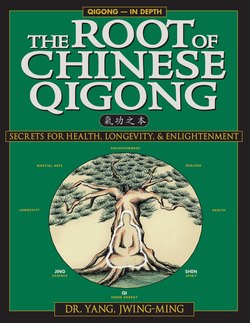Читать книгу The Root of Chinese Qigong - Jwing-Ming Yang - Страница 9
На сайте Литреса книга снята с продажи.
ОглавлениеPreface New Edition
Since 1989, when this book was first introduced to the public, more than thirty thousand copies have been sold. This is better than I originally expected. The reason for this is simply because the subject of Qigong was still very new to Western readers, even though it has been studied and practiced in China, Japan, and India for many thousands of years. Therefore, the market is very small and restricted to those already interested in Chinese culture. In addition, this book is considered to be an in-depth theoretical treatise on Qigong. It is like a piece of classical music, instead of rock music, which can be understood and accepted easily by the general society.
Qigong today, like Taijiquan in the early 1980’s, is being understood and welcomed in the West. I believe that there are a few reasons for this. First, since President Nixon visited mainland China in 1973 and opened the gates to the nation, there has been more and more culture exchange between China and the West. The Western world has a better understanding of Chinese culture. This has agitated and stimulated many Westerners to take an interest in Chinese culture, study it, and accept it. Second, Chinese acupuncture and Qigong healing techniques have been widely accepted. Alternative medicine, as it was originally called, is now considered to be “complimentary medicine.” Finally, the general public is more open minded, and the bondage of tradition, especially religious tradition, has been reduced to its lowest point ever. This open-minded attitude has generated great interest in foreign cultures.
Since 1989, I have written and published 10 more books and 15 videotapes to introduce Chinese culture to the Western society. YOAA, Inc. (Yang’s Oriental Arts Association, Inc.) was established to expedite this cultural exchange. YMAA Publication Center is the division that handles the publications. In addition, YMAA has also established more than 30 schools and three publication centers in Europe to translate these books into non-English languages. Currently, many YMAA books have been translated into French, Italian, Spanish, Polish, Hungarian, Bulgarian, Russian, and Czech.
In 1989 when this book was written, I had a dream of introducing in-depth Qigong books to the West. The books I wanted to write include:
1. The Root of Chinese Qigong — The Secrets of Qigong Training
2. Muscle/Tendon Changing and Marrow/Brain Washing Chi Kung — The Secret of Youth (Yi Jin Jing and Xi Sui Jing)()
3. Chinese Qigong Massage — Qigong Tui Na and Cavity Press for Healing (Qigong An Mo and Qigong Dian Xue)()
4. Qigong and Health — For Healing and Maintaining Health
5. Qigong and Martial Arts — The Key to Advanced Martial Arts Skill (Shaolin, Wudang, Emei, and others)
6. Buddhist Qigong — Chan, The Root of Zen()
7. Daoist Qigong (Dan Ding Dao Gong)()
8. Tibetan Qigong (Mi Zang Shen Gong)()
This is the first of those books. The second, Muscle/Tendon Changing and Marrow/Brain Washing Chi Kung, was also published in 1989. The first half of the Chinese Qigong Massage, General Massage, was published in 1992. The second half, about Tui Na, Dian Xue, and Qi massage, is still being written. Qigong and Health has not yet been started. Qigong and Martial Arts has been written under the title: The Essence of Shaolin White Crane, which was published in 1996. Buddhist Qigong and Tibetan Qigong have not yet been started. Currently, I am working on Daoist Qigong which will be published as two new titles: Small Circulation Meditation and Grand Circulation and Enlightenment Meditation. I plan to complete these two volumes by 1999. The writing process is slow and time consuming. This is especially significant since almost all of the Qigong documents were released to the general public in the last ten years, both in China and Taiwan.
This has provided me with ten-fold the amount of information. Naturally, this has also offered me a greater chance to make the future books more complete and in-depth. There is another reason for the slow progress. The market for the in-depth books, especially those that relate to inner Qigong feelings and spiritual cultivation, is very limited. In order to prevent any financial difficulty in the publication business, I have also put a lot of time and effort into writing other smaller introductory books for Qigong healing and martial arts. As I pointed out in the original preface, the translation and interpretation of the Qigong from Chinese to English is not easy. We will need an organization that has strong financial support and many Qigong experts to do the job. I will just try my best to contribute what I can. I sincerely hope that the government, universities, or private organizations will sponsor this project to expedite this Qigong cultural exchange.
In this new edition, some new concepts have been added and some old concepts have been deleted. Not only that, for those readers who understand, the Chinese characters are immediately included in the text when the Chinese is mentioned. In addition, when this book was written, the Chinese romanization system called Pinyin was not yet popular. Therefore, an older system was used. However, Pinyin is now widely used in the West in both scholastic and lay societies, so this book follows the Pinyin romanization system. In addition, new typesetting has been done to make this book easier to read. Finally, the glossary and translation of Chinese terms have been combined, and an index has been added.
Dr. Yang, Jwing-Ming Boston, January 15, 1997
